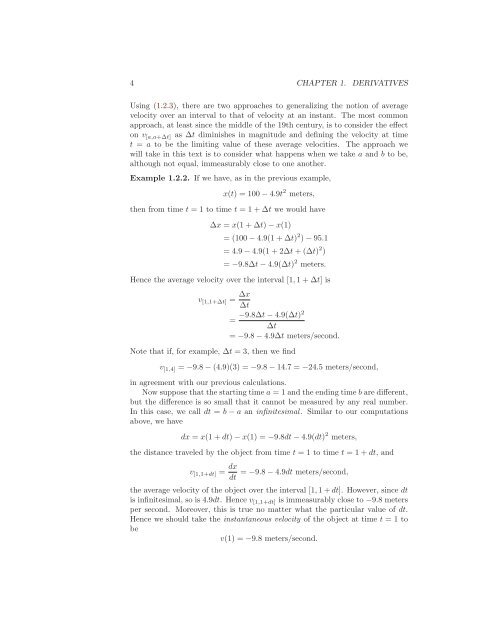Yet Another Calculus Text, 2007a
Yet Another Calculus Text, 2007a
Yet Another Calculus Text, 2007a
You also want an ePaper? Increase the reach of your titles
YUMPU automatically turns print PDFs into web optimized ePapers that Google loves.
4 CHAPTER 1. DERIVATIVES<br />
Using (1.2.3), there are two approaches to generalizing the notion of average<br />
velocity over an interval to that of velocity at an instant. The most common<br />
approach, at least since the middle of the 19th century, is to consider the effect<br />
on v [a,a+Δt] as Δt diminishes in magnitude and defining the velocity at time<br />
t = a to be the limiting value of these average velocities. The approach we<br />
will take in this text is to consider what happens when we take a and b to be,<br />
although not equal, immeasurably close to one another.<br />
Example 1.2.2. If we have, as in the previous example,<br />
x(t) = 100 − 4.9t 2 meters,<br />
then from time t = 1 to time t =1+Δt we would have<br />
Δx = x(1 + Δt) − x(1)<br />
= (100 − 4.9(1 + Δt) 2 ) − 95.1<br />
=4.9 − 4.9(1 + 2Δt +(Δt) 2 )<br />
= −9.8Δt − 4.9(Δt) 2 meters.<br />
Hence the average velocity over the interval [1, 1+Δt] is<br />
v [1,1+Δt] = Δx<br />
Δt<br />
−9.8Δt − 4.9(Δt)2<br />
=<br />
Δt<br />
= −9.8 − 4.9Δt meters/second.<br />
Note that if, for example, Δt =3,thenwefind<br />
v [1,4] = −9.8 − (4.9)(3) = −9.8 − 14.7 =−24.5 meters/second,<br />
in agreement with our previous calculations.<br />
Now suppose that the starting time a = 1 and the ending time b are different,<br />
but the difference is so small that it cannot be measured by any real number.<br />
In this case, we call dt = b − a an infinitesimal. Similar to our computations<br />
above, we have<br />
dx = x(1 + dt) − x(1) = −9.8dt − 4.9(dt) 2 meters,<br />
the distance traveled by the object from time t = 1 to time t =1+dt, and<br />
v [1,1+dt] = dx = −9.8 − 4.9dt meters/second,<br />
dt<br />
the average velocity of the object over the interval [1, 1+dt]. However, since dt<br />
is infinitesimal, so is 4.9dt. Hence v [1,1+dt] is immeasurably close to −9.8 meters<br />
per second. Moreover, this is true no matter what the particular value of dt.<br />
Hence we should take the instantaneous velocity of the object at time t =1to<br />
be<br />
v(1) = −9.8 meters/second.


















